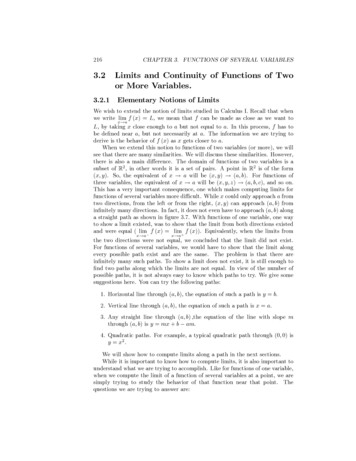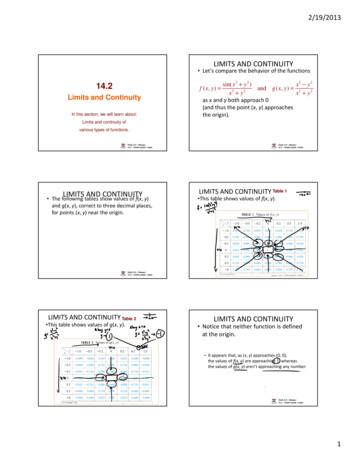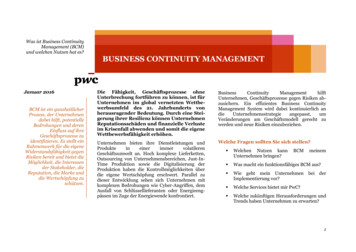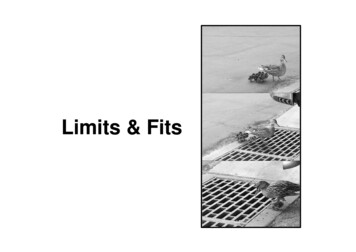
Transcription
2163.23.2.1CHAPTER 3. FUNCTIONS OF SEVERAL VARIABLESLimits and Continuity of Functions of Twoor More Variables.Elementary Notions of LimitsWe wish to extend the notion of limits studied in Calculus I. Recall that whenwe write lim f (x) L, we mean that f can be made as close as we want tox!aL, by taking x close enough to a but not equal to a. In this process, f has tobe de ned near a, but not necessarily at a. The information we are trying toderive is the behavior of f (x) as x gets closer to a.When we extend this notion to functions of two variables (or more), we willsee that there are many similarities. We will discuss these similarities. However,there is also a main di erence. The domain of functions of two variables is asubset of R2 , in other words it is a set of pairs. A point in R2 is of the form(x; y). So, the equivalent of x ! a will be (x; y) ! (a; b). For functions ofthree variables, the equivalent of x ! a will be (x; y; z) ! (a; b; c), and so on.This has a very important consequence, one which makes computing limits forfunctions of several variables more di cult. While x could only approach a fromtwo directions, from the left or from the right, (x; y) can approach (a; b) fromin nitely many directions. In fact, it does not even have to approach (a; b) alonga straight path as shown in gure 3.7. With functions of one variable, one wayto show a limit existed, was to show that the limit from both directions existedand were equal ( lim f (x) lim f (x)). Equivalently, when the limits fromx!ax!athe two directions were not equal, we concluded that the limit did not exist.For functions of several variables, we would have to show that the limit alongevery possible path exist and are the same. The problem is that there arein nitely many such paths. To show a limit does not exist, it is still enough to nd two paths along which the limits are not equal. In view of the number ofpossible paths, it is not always easy to know which paths to try. We give somesuggestions here. You can try the following paths:1. Horizontal line through (a; b), the equation of such a path is y b.2. Vertical line through (a; b), the equation of such a path is x a.3. Any straight line through (a; b) ;the equation of the line with slope mthrough (a; b) is y mx b am:4. Quadratic paths. For example, a typical quadratic path through (0; 0) isy x2 .We will show how to compute limits along a path in the next sections.While it is important to know how to compute limits, it is also important tounderstand what we are trying to accomplish. Like for functions of one variable,when we compute the limit of a function of several variables at a point, we aresimply trying to study the behavior of that function near that point. Thequestions we are trying to answer are:
3.2. LIMITS AND CONTINUITY OF FUNCTIONS OF TWO OR MORE VARIABLES.217Figure 3.7: Possible paths through (a; b)1. Does the function behave "nicely" near the point in questions? In otherwords, does the function seem to be approaching a single value as its inputis approaching the point in question?2. Is the function getting arbitrarily large (going to 1 or1)?3. Does the function behave erratically, that is it does not seem to be approaching any value?In the rst case, we will say that the limit exists and is equal to the valuethe function seems to be approaching. In the other cases, we will say that thelimit does not exist. We have the following de nition:De nition 3.2.1 We writelim(x;y)!(a;b)f (x; y) L and we read the limit off (x; y) as (x; y) approaches (a; b) is L, if we can make f (x; y) as close aswe want to L, simply by taking (x; y) close enough to (a; b) but not equal to it.Remark 3.2.2 It is important to note that when computinglim(x;y)!(a;b)f (x; y),(x; y) is never equal to (a; b). In fact, the function may not even be de ned at(a; b), yet the limit may still exist. While (a; b) may not be in the domain of f ,the points (x; y) we consider as (x; y) ! (a; b) are always in the domain of f .Remark 3.2.3 There are several notation for this limit. They all represent thesame thing, we list them below.
218CHAPTER 3. FUNCTIONS OF SEVERAL VARIABLES1.lim(x;y)!(a;b)f (x; y) L2. x!alim f (x; y) Ly!b3. f (x; y) approaches L as (x; y) approaches (a; b).We now look at how limits can be computed.3.2.2Finding Limits Using the Numerical MethodWe try to estimate or "guess" if a limit exists and what its value is by lookingat a table of values. Such a table will be more complicated than in the case offunctions of one variable. When (x; y) ! (a; b), we have to consider all possiblecombinations of x ! a and y ! b. This usually results in a square table as theones shown below.Example 3.2.4 Consider the function f (x; y) values to "guess"limf (x; y).sin(x2 y 2 ).x2 y 2Use a table of(x;y)!(0;0)We begin by making a table of values of f (x; y) for (x; y) close to (0; 0:8290:7590:455Looking at the table, we can estimate the limit along certain paths. For example,each column of the table gives the function values for a xed y value. In thecolumn corresponding to y 0, we have the values of f (x; 0) for values of xclose to 0, from either direction. So we can estimate the limit along the pathy 0. In fact, the column corresponding to y b can be used to estimate thelimit along the path y b. Similarly, the row x a can be used to estimatethe limit along the path x a: The diagonal of the table from the top left tothe bottom right correspond to values x y. It can be used to estimate thelimit along the path y x. The other diagonal, from top right to bottom leftcorresponds to y x. So, it can be used to estimate the limit along the pathy x. Looking at the table, it seems that the limit along any of the pathsdiscussed appears to be 1. While this does not prove it for sure, as there aremany more paths to consider, this gives us an indication that it might be. Wecan then try to use other methods we will discuss in the next sections to try toshow the limit is indeed 1. It turns out this limit is indeed 1.
3.2. LIMITS AND CONTINUITY OF FUNCTIONS OF TWO OR MORE VARIABLES.219Example 3.2.5 Consider the function g (x; y) to "guess"limg (x; y).x2 y 2x2 y 2 .Use a table of values(x;y)!(0;0)We begin by making a table of values of g (x; y) for (x; y) close to (0; 00:60:92310:9230:60Looking at the table as indicated in the previous example, we see that the limitalong the path y 0 appears to be 1 while the limit along the path x 0 appearsto be 1. This proveslimg (x; y) does not exist.(x;y)!(0;0)Example 3.2.6 Consider the function h (x; y) to "guess"limh (x; y).x2 yx4 y 2 .Use a table of values(x;y)!(0;0)We begin by making a table of values of h (x; y) for (x; y) close to (0; :23520:03900:0390:23520:5Looking at this table as indicated in the previous examples, it appears that thelimit along the paths x 0, y 0, y x and y x is 0. However, as we willsee in the next section, this limit does not exist. In this case, the table wouldhave given the wrong indication.In conclusion, we see that tables do not provide as good an answer as in thecase of functions of one variable. They can be helpful when the limit does notexist, if the table shows two paths leading to a di erent limit. However, sincethe number of paths we can see on the table is limited, they will not, in generaltell us for sure if a limit exists. They can still be used to get an idea of whetherthe limit might exist and what it might be. Given a function, and a limit tocompute, if one does not have any idea of what this function does, looking at atable of values might help to point the person in one direction. Usually, solvinga problem is easier if one has an idea of what the answer might be. So, while the
220CHAPTER 3. FUNCTIONS OF SEVERAL VARIABLESuse of such tables is more limited than in the case of functions of one variable,these tables are not useless.3.2.3Finding Limits Using the Analytical MethodComputing limits using the analytical method is computing limits using thelimit rules and theorems. We will see that these rules and theorems are similarto those used with functions of one variable. We present them without proof,and illustrate them with examples.Theorem 3.2.7 (Properties of Limits of Functions of Several Variables)We list these properties for functions of two variables. Similar properties holdfor functions of more variables. Let us assume that L, M , and k are real numbersand thatlimf (x; y) L andlimg (x; y) M , then the following(x;y)!(a;b)(x;y)!(a;b)hold:1. First, we have the obvious limitslimx alimy b(x;y)!(a;b)(x;y)!(a;b)If c is any constant,lim(x;y)!(a;b)c c2. Sum and di erence rules:lim(x;y)!(a;b)[f (x; y)g (x; y)] LM3. Constant multiple rule:lim(x;y)!(a;b)[kf (x; y)] kL4. Product rule:lim(x;y)!(a;b)[f (x; y) g (x; y)] LM5. Quotient rule:lim(x;y)!(a;b)Lf (x; y) g (x; y)Mprovided M 6 0.6. Power rule: If r and s are integers with no common factors, and s 6 0thenrrlim[f (x; y)] s L s(x;y)!(a;b)rprovided L s is a real number. If s is even, we assume L 0.
3.2. LIMITS AND CONTINUITY OF FUNCTIONS OF TWO OR MORE VARIABLES.221Theorem 3.2.8 The above theorem applied to polynomials and rational functions implies the following:1. To nd the limit of a polynomial, we simply plug in the point.2. To nd the limit of a rational function, we plug in the point as long as thedenominator is not 0.Example 3.2.9 Findlim(x;y)!(1;2)x6 y 2xyCombining the rules mentioned above allows us to do the followinglim(x;y)!(1;2)x6 y 2xy 16 2 2 (1) (2) 2 4 6x2 y4 y 2x(x;y)!(1;1)Example 3.2.10 FindlimCombining the rules mentioned above allows us to do the followingx2 y y2lim(x;y)!(1;1) x412 1 12 1412 Remark 3.2.11 Like for functions of one variable, the rules do not apply when"plugging-in" the point results in an indeterminate form. In that case, we mustuse techniques similar to the ones used for functions of one variable. Suchtechniques include factoring, multiplying by the conjugate. We illustrate themwith examples.Example 3.2.12 Findx3 y 3(x;y)!(0;0) x ylimWe cannot plug in the point as we get 0 in the denominator. We try to rewritethe fraction to see if we can simplify it.x3(x;y)!(0;0) xlimy3y Example 3.2.13 Findlim(x;y)!(0;0)lim(x;y)!(0;0)y) x2 xy y 2x yx2 xy y 20x2px(x;y)!(0;0)lim(xxypy0Here, we cannot plug in the point because we get , an indeterminate form.0Since this is a fraction which involves a radical, we multiply by the conjugate.
222CHAPTER 3. FUNCTIONS OF SEVERAL VARIABLESWe get:x2plimx(x;y)!(0;0)xypy 3.2.4ppx ylimpp(x;y)!(0;0)x yppx (x y) x ylimx y(x;y)!(0;0)ppx x ylim1(x;y)!(0;0)0x2pxxypyLimit Along a PathWe have mentioned several times above how important taking the limit alonga speci c path might be. In particular, one way to prove thatlimf (x; y)(x;y)!(a;b)does not exist is to prove that this limit has di erent values along two di erentpaths. We now look at several examples to see how this might be done. Ingeneral, you need to remember that specifying a path amounts to giving somerelation between x and y. When computing the limit along this path, use therelation which de nes the path. For example, when computing the limit alongthe path y 0, replace y by 0 in the function. If computing the limit along thepath y x, replace y by x in the function. And so on.Make sure that the path you select goes through the point at whichwe are computing the limit.Example 3.2.14 Consider the function f (x; y) y ndlimx y 1 .yx y 1 .The goal is to try to(x;y)!(1;0)You may remember from Calculus I that in many cases, to compute a limit wesimply plugged-in the point. If you try to do this here, you obtain 00 which is anindeterminate form. It does not mean the limit does not exist. It means thatyou need to study it further. We will do this by looking at the limit along variouspaths. As mentioned in the introduction, some obvious paths we might try arethe path x 1 and y 0.1. Limit along the path y 0. First, we nd what the function becomes alongthis path. We will use the notation x yy 1to mean x yy 1 along thepath y 0 andy(x;y)!(1;0) x y 1limy 0to meanylim(x;y)!(1;0) x y 1alon g y 0y 0. We have:yx y1 y 0 0x01along the path
3.2. LIMITS AND CONTINUITY OF FUNCTIONS OF TWO OR MORE VARIABLES.223Also, note that along the path y 0, y is constant hence (x; y) ! (1; 0)can be replaced by x ! 1. Thereforey(x;y)!(1;0) x ylim1 lim 0x!1alon g y 0 -4020-410-2-2z 00 0-10y 2-20 2 x-30442. Limit along the path x 1. We have:yx y1 x 1 y1 yyy11Hence,lim(x;y)!(1;0) xalon g x 1y y1 lim 1y!01
224CHAPTER 3. FUNCTIONS OF SEVERAL VARIABLES-420-4-2z400 0-202y-22x43. Conclusion: The limits are di erent, thereforeylim(x;y)!(1;0) x y 1does notexist.Example 3.2.15 Consider the function f (x; y) ndx2 y 2x2 y 2 .The goal is to try tox2 y 2lim22.(x;y)!(0;0) x yAs mentioned in the introduction, some obvious paths we might try are the pathx 0 and y 0. Note that we can also combine both computations ( ndingwhat the function is along the path and nding the limit).1. Limit along the path x 0. Along this path, we havex2 y 2(x;y)!(0;0) x2 y 2lim lim(x;y)!(0;0)x2 y 2x2 y 2alon g x 0 lim(x;y)!(0;0)lim(x;y)!(0;0)1y2y21x 0
3.2. LIMITS AND CONTINUITY OF FUNCTIONS OF TWO OR MORE VARIABLES.225-41-2-4-2zy00 0-122x442. Limit along the path y 0. Along this path, we havelim(x;y)!(0;0)alon g y 0y 0x2 y 2x2 y 2 lim22x y(x;y)!(0;0) x2 y 2x2(x;y)!(0;0) x2 lim1 lim(x;y)!(0;0) 1y 0
226CHAPTER 3. FUNCTIONS OF SEVERAL VARIABLES1-4-4-2y24-200 0z2-1x4x2 y 222(x;y)!(0;0) x y3. Conclusion: The limits are di erent, thereforelimdoes notexist.Example 3.2.16 Prove thatxylim22(x;y)!(0;0) x ydoes not exist.First, we try the limit along the paths x 0 and y 0. The user will checkthat both limits are 0. Next, we try along the path y x. We getlim(x;y)!(0;0) x2xy y2 lim(x;y)!(0;0) x2xy y2alon g y x lim(x;x)!(0;0) x2y xx2 x2x2(x;x)!(0;0) 2x21 lim(x;x)!(0;0) 21 2 We obtained a di erent limit. So,Example 3.2.17 Prove thatlimxylim22(x;y)!(0;0) x yx2 y4 y 2x(x;y)!(0;0)limdoes not exist.does not exist.You will recognize this function, it is the function in the third table we didearlier. From the table, it appeared that the limit along the paths x 0, y 0,
3.2. LIMITS AND CONTINUITY OF FUNCTIONS OF TWO OR MORE VARIABLES.227and y x was 0. Yet, you were told the limit did not exist. We prove it here.The reader will check that if we compute the limit along the paths x 0, y 0,y x, we obtain 0 every time. In fact, the limit along any straight path through(0; 0) is 0. The equation of such a path is y mx. Along this path, we getx2 y(x;y)!(0;0) x4 y 2 limlim(x;y)!(0;0)x2 yx4 y 2alon g y mx lim(x;mx)!(0;0) x4y mxmx3 m 2 x2mx3(x2 m2 )mx lim 2x!0 x m2 0 limx!0 x2However, we will get a di erent answer along the path y x2 .x2 y(x;y)!(0;0) x4 y 2 limlim(x;y)!(0;0)x2 yx4 y 2alon g y x2 This proves that3.2.5x2 ylim42(x;y)!(0;0) x ylim2(x;x )!(0;0) x4y x2x4 x4x4x!0 2x41limx!0 212limdoes not exist.Additional Techniques to Find Limits: Change ofCoordinates and Squeeze Theorem or Sandwich TheoremSometimes, changing coordinates may be useful. Consider the example below.Example 3.2.18 Using polar coordinates, ndx3 y 322.(x;y)!(0;0) x ylimRecall that the relationship between a point in polar coordinates (r; ) with rand rectangular coordinates (x; y) isx r cosy r sin0
228CHAPTER 3. FUNCTIONS OF SEVERAL VARIABLESFrom which, we can see thatx2 y 2 r2 cos2 r2 sin2 r2 cos2 sin2 r2andx3 y 3 r3 cos3 r3 sin3 r3 cos3 sin3Also, saying (x; y) ! (0; 0) is equivalent to saying r ! 0 . Hence, we have:x3 y 3(x;y)!(0;0) x2 y 2lim lim r!0r3 cos3 sin3r2lim r cos3 sin3r!0 0There is also an equivalent of the squeeze theorem. Suppose we are tryingto ndlimf (x; y) given f (x; y) and we suspect the limit might be L.(x;y)!(a;b)Theorem 3.2.19 Suppose that jf (x; y) Ljg (x; y) for every (x; y) insidea disk centered at (a; b) ;except maybe at (a; b). Iflimg (x; y) 0 then(x;y)!(a;b)lim(x;y)!(a;b)f (x; y) L.The di culty with this theorem is that we must suspect what the limit isgoing to be. This is not too much of a problem. If you have tried a table ofvalues and found that along all the paths the table allows you to investigate,the limit is the same, or if you have tried to compute the limit along di erentpaths and have found the same value every time. Then, you might suspect thelimit exists and is the common value you have found. It is this value you wouldtry in the squeeze theorem. The second di culty is nding the function g. Thisis done using approximation of the initial function f . How it is done dependson f . We illustrate how to do it with a few examples.Example 3.2.20 Findlim(x;y)!(0;0)f (x; y) for f (x; y) x2 yx2 y 2 .The reader will check that computing this limit along various paths such as x 0,y 0, y x gives 0. So, you might start suspecting the limit exists and is 0. Wenow use the squeeze theorem to try to prove it. In other words, we need to nda function g (x; y) such that jf (x; y) 0j g (x; y) andlimg (x; y) 0.(x;y)!(0;0)
3.2. LIMITS AND CONTINUITY OF FUNCTIONS OF TWO OR MORE VARIABLES.229To nd g, we proceed as follows:jf (x; y)x2 yx2 y 2x2 yx2 y 20j 0x2 y y2 j jx2x2 jyjsince x2 y 2x2 y 2x2 jyjx2 y 2 0we can make a fraction bigger by making its denominator smaller. Thus, wehavex2 jyjx2 y 2x2 jyjx2 jyjjf (x; y)0j If we let g (x; y) jyj, we see thattheorem,lim(x;y)!(0;0)lim(x;y)!(0;0)g (x; y) 0. Thus, by the squeezef (x; y) 0.Example 3.2.21 Findlim(x;y)!(1;0)f (x; y) for f (x; y) (x 1)2 ln x.(x 1)2 y 2The reader will verify that the limit along the paths x 1, y 0, y x 1is always 0. So, we suspect the limit we want might be 0. We now use thesqueeze theorem to try to prove it. In other words, we need to nd a functiong (x; y) such that jf (x; y) 0j g (x; y) andlimg (x; y) 0. To nd g,(x;y)!(0;0)we proceed as follows:jf (x; y)0j jf (x; y)j 2(x1) ln x(x1) y 2(x221) jln xj2(x 1) y 2jln xjSince jln xj ! 0 as (x; y) ! (1; 0), it follows by the squeeze theorem thatlimf (x; y) 0.(x;y)!(1;0)
230CHAPTER 3. FUNCTIONS OF SEVERAL VARIABLESThere is another version of the squeeze theorem. As before, we suppose weare trying to ndlimf (x; y) given f (x; y).(x;y)!(a;b)Theorem 3.2.22 If g (x; y)f (x; y)disk centered at (x0 ; y0 ) and iflimh (x; y) for all (x; y) 6 (x0 ; y0 ) in ag (x; y) limh (x; y) L(x;y)!(x0 ;y0 )thenlim(x;y)!(x0 ;y0 )(x;y)!(x0 ;y0 )f (x; y) L.Here, the di culty is to nd the two functions g and h which satisfy theinequality and have a common limit. We illustrate this with an example.Example 3.2.23 Does knowing that 2 jxyjp4 4 cos jxyj?help you with ndinglimjxyjx2 y 2644 cos(x;y)!(0;0)pjxyj2 jxyjIf we divide the inequality we have by jxyj, then we will have an inequalityinvolving the function for which we want the limit. If the two outer functions inour new inequality have the same limit, then we will be done. Dividing each sideof the given inequality by jxyj which is positive (hence preserves the inequality)gives usp2 22 jxyj x 6y4 4 cos jxyj2 jxyjjxyjjxyjjxyjthat is2 22 jxyj x 6yjxyjWe compute2jxyj xjxyj(x;y)!(0;0)lim4p4 cos jxyjjxyj22 y26. We cannot just plug in the point because weget 00 . We will eliminate the absolute value by considering cases.case 1: xy 0. In this case, jxyj xy hence2 22 jxyj x 6ylimjxyj(x;y)!(0;0) lim(x;y)!(0;0)x2 y 262xyxyxy 2 xy6limxy(x;y)!(0;0)xylim26(x;y)!(0;0)2
3.2. LIMITS AND CONTINUITY OF FUNCTIONS OF TWO OR MORE VARIABLES.231case 2: xy 0. In this case, jxyj xy hence2 22 jxyj x 6ylimjxyj(x;y)!(0;0) in conclusion:2jxyj xjxyj(x;y)!(0;0)limx2 y y 2 xyxy2 6xy622 y26 2 and sincelim(x;y)!(0;0)2 2, we are ex-actly in the situation of the squeeze theorem. We conclude that2.3.2.6Limits with MapleTo computelim(x;y)!(a;b)f (x; y), uselimit( f (x; y) ; fx a; y bg );3.2.7ContinuityLike in Calculus I, the de nition of continuity is:De nition 3.2.24 A function f (x; y) is said to be continuous at a point (a; b)if the following is true:1. (a; b) is in the domain of f .2.3.limf (x; y) exists.limf (x; y) f (a; b)(x;y)!(a;b)(x;y)!(a;b)p4 4 cos jxyjjxyj(x;y)!(0;0)limDe nition 3.2.25 If a function f is not continuous at a point (a; b), we saythat it is discontinuous at (a; b).De nition 3.2.26 We say that a function f is continuous on a set D if it iscontinuous at every point in D.Thus, if we know that a function is continuous at a point, to nd the limitof the function at the point it is enough to plug-in the point. We now reviewrules and theorem which allow us to determine if a function is continuous at apoint, or where a function is continuous.
232CHAPTER 3. FUNCTIONS OF SEVERAL VARIABLESTheorem 3.2.27 The following results are true for multivariable functions:1. The sum, di erence and product of continuous functions is a continuousfunction.2. The quotient of two continuous functions is continuous as long as thedenominator is not 0.3. Polynomial functions are continuous.4. Rational functions are continuous in their domain.5. If f (x; y) is continuous and g (x) is de ned and continuous on the rangeof f , then g (f (x; y)) is also continuous.We now look at several examples.Example 3.2.28 Is f (x; y) x2 y 3x3 y 4 x 2y continuous at (0; 0)? Whereis it continuous?f (x; y) is a polynomial function, therefore it is continuous on R2 . In particular,it is continuous at (0; 0).yExample 3.2.29 Where is f (x; y) x2x2 y 2 continuous?f is the quotient of two continuous functions, therefore it is continuous as longas its denominator is not 0 that is on R2 f(0; 0)g.Example 3.2.30 Where is f (x; y) x21 y continuous?As above, f is the quotient of two continuous functions. Therefore, it is continuous as long as its denominator is not 0. The denominator is 0 along theparabola y x2 . Therefore, f is continuous on (x; y) 2 R2 j y 6 x2 .Example 3.2.31 Find where tan1xy 2x yis continuous.Here, we have the composition of two functions. We know that tan 1 is conxy 2tinuous on its domain, that is on R. Therefore, tan 1 x ywill be contin22xyxyuous where x yis continuous. Since x yis the quotient of two polynomialfunctions, therefore it will be continuous as long as its denominator is notxy 20, that is as long as y 6 x. It follows that tan 1 x yis continuous on(x; y) 2 R2 : y 6 x .Example 3.2.32 Find where ln x2 y 2 1 is continuous.Again, we have the composition of two functions. ln is continuous where it isde ned, that is on fx 2 R : x 0g. So, ln x2 y 2 1 will be continuous aslong as x2 y 2 1 is continuous and positive. x2 y 2 1 is continuous onR2 , but x2 y 2 1 0 if and only if x2 y 2 1, that is outside the circle ofradius 1, centered at the origin. It follows that ln x2 y 2 1 is continuous ofthe portion of R2 outside the circle of radius 1, centered at the origin.
3.2. LIMITS AND CONTINUITY OF FUNCTIONS OF TWO OR MORE VARIABLES.233Example 3.2.33 Where is f (x; y) (x2 y 2x2 y 20if (x; y) 6 (0; 0)at(0; 0)continu-ous?Away from (0; 0), f is a rational function always de ned. So, it is continuous.We still need to investigate continuity at (0; 0). In an earlier example, we foundx2 y 2thatlimx2 y 2 did not exist. Therefore, f is continuous everywhere except(x;y)!(0;0)at (0; 0).Example 3.2.34 Where is f (x; y) (x2 yx2 y 20if (x; y) 6 (0; 0)at(0; 0)continu-ous?Away from (0; 0), f is a rational function always de ned. So, it is continuous.We still need to investigate continuity at (0; 0). In an earlier example, we foundx2 ythatlimx2 y 2 0. Therefore, f is also continuous at (0; 0). It follows(x;y)!(0;0)that f is continuous everywhere.Remark 3.2.35 If the function of the example we just did had been de nedsuch that f (0; 0) 1, then it would not have been continuous at (0; 0) since thevalue of the limit at (0; 0) would not be the same as the value of the function.3.2.8ProblemsMake sure you have read, studied and understood what was done above beforeattempting the problems.1. Find2. Find3. Find4. Find5. Find3x2 y 2 522(x;y)!(0;0) x y 2limlim(x;y)!(3;4)limpx2 y 2(x;y)!(0; 4 )limsec x tan x(x;y)!(0;ln 2)lim(x;y)!(0;0)exyey sin xx6. Findx sin ylim2(x;y)!(1;0) x 17. Findx2 2xy y 2x y(x;y)!(1;1)8. Find9. Findlimlim(x;y)!(1;1)1xy y 2x 2x 1by rst rewriting the fraction.by rst rewriting the fraction.ppx y 2 x 2 yppxy(x;y)!(0;0)limby rst rewriting the fraction.
234CHAPTER 3. FUNCTIONS OF SEVERAL VARIABLES10. Findp2x y 2(x;y)!(2;0) 2x y 4lim11. Let P (x; y; z). Find12. Let P (x; y; z). Find13. Let P (x; y; z). Findby rst rewriting the fraction.1xlimP !(1;3;4)lim1y 1zsin2 x cos2 y sec2 zlimP !(3;3;0)P !( ;0;3) ze2ycos 2x14. At what points in the plane is f (x; y) continuous?(a) f (x; y) sin (x y).(b) f (x; y) ln x2 y 2 .15. At what points in the plane is g (x; y) continuous?1(a) g (x; y) sin xy(b) g (x; y) x y2 cos x .16. At what points in space is f (x; y; z) continuous?(a) f (x; y; z) x2 y 2 2z 2 .p(b) f (x; y; z) x2 y 2 117. At what points in space is g (x; y; z) continuous?(a) g (x; y; z) xy sin z1 .(b) g (x; y; z) x2 z12 1 .18. By considering di erent paths, show thatlim(x;y)!(0;0)pxx2 y 219. By considering di erent paths, show thatx2 y 2lim22(x;y)!(0;0) x y20. By considering di erent paths, show thatx ylim(x;y)!(0;0) x y21. By considering di erent paths, show thatx2 y(x;y)!(0;0) y22. Show that f (x; y) ing (0; 0).2x2 yx4 y 2limdoes not exist.does not exist.does not exist.has limit 0 along every straight line approach-23. Does knowing that1does not exist.x2 y 2tan 1 xy 13xytell us anything abouttan 1 xyxy(x;y)!(0;0)lim
3.2. LIMITS AND CONTINUITY OF FUNCTIONS OF TWO OR MORE VARIABLES.23524. Does knowing thatsin1x1tell us anything aboutlim(x;y)!(0;0)25. Consider the function f (x; y) 2xyx2 y 2 .1xy sinSuppose we want to ndlim(x;y)!(0;0)f (x; y).2m(a) Along the path y mx, the function becomes 1 m2 . Substitutingm tan , show how the value of f varies with the line’s angle ofinclination.So, the value does depend solely on .(b) Use the formula obtained in part a to show that the limit along theline y mx varies from 1 to 1 depending on the angle of approach.26. Use polar coordinates to ndx3 xy 2lim22 .(x;y)!(0;0) x y27. Use polar coordinates to ndy2lim22(x;y)!(0;0) x y28. Use polar coordinates to nd3.2.9lim(x;y)!(0;0)tan1 jxj jyjx2 Y 2Answers1. Find3x2 y 2 5lim22(x;y)!(0;0) x y 23x2 y 2 55 2(x;y)!(0;0) x2 y 2 2lim2. Findlim(x;y)!(3;4)px2 y 21lim(x;y)!(3;4)3. Findlim(x;y)!(0; 4 )psec x tan xlim(x;y)!(0; 4 )4. Findlimp1 2 6x2 y 2(x;y)!(0;ln 2)exsec x tan x 1ylim(x;y)!(0;ln 2)exy 12
2365. FindCHAPTER 3. FUNCTIONS OF SEVERAL VARIABLESey sin xx(x;y)!(0;0)limey sin x 1x(x;y)!(0;0)lim6. Findx sin ylim2(x;y)!(1;0) x 1lim(x;y)!(1;0)7. Findx2 2xy y 2x y(x;y)!(1;1)limby rst rewriting the fraction.x2lim(x;y)!(1;1)8. Findlim(x;y)!(1;1)xy y 2x 2x 1xylimppx y 2 x 2 yppxy(x;y)!(0;0)limyxp2x y 2(x;y)!(2;0) 2x y 4limby rst rewriting the fraction.p12x y 2 2x y 44lim(x;y)!(2;0)11. Let P (x; y; z). Find1xlimP !(1;3;4)lim13. Let P (x; y; z). Find1y 1z 1912sin2 x cos2 y sec2 zlimP !(3;3;0)P !(3;3;0) 11 1 x y zlimP !(1;3;4)12. Let P (x; y; z). Find1ppy 2 x 2 yp 2pxyxlim2x 2 1by rst rewriting the fraction.(x;y)!(0;0)10. Find2xy y 2 0x yby rst rewriting the fraction.(x;y)!(1;1)9. Findx sin y 0x2 1sin2 x cos2 y sec2 z 2limzelimzeP !( ;0;3)P !( ;0;3)2y2ycos 2xcos 2x 3
3.2. LIMITS AND CONTINUITY OF FUNCTIONS OF TWO OR MORE VARIABLES.23714. At what points in the plane is f (x; y) continuous?(a) f (x; y) sin (x y).f (x; y) is continuous on R2 .(b) f (x; y) ln x2 y 2 .f is continuous for all (x; y) except (0; 0).15. At what points in the plane is g (x; y) continuous?1(a) g (x; y) sin xy.g (x; y) is continuous for all (x; y) not on the x or y-axes.x y(b) g (x; y) 2 cosx.g is always continuous.16. At what points in space is f (x; y; z) continuous?(a) f (x; y; z) x2 y 2 2z 2 .Continuous at all points since it is a polynomial.p(b) f (x; y; z) x2 y 2 1f is continuous outside the cylinder of radius 1 along the z-axis.17. At what points in space is g (x; y; z) continuous?(a) g (x; y; z) xy sin z1 .g is continuous as long as z 6 0.(b) g (x; y; z) x2 z12 1 .g is continuous as long as x2 z 2 6 1.18. By considering di erent paths, show thatlim(x;y)!(0;0)pxx2 y 2does not exist.Just follow the instructions.19. By considering di erent paths, show thatx2 y 2lim22(x;y)!(0;0) x ydoes not exist.Just follow the instructions.20. By considering di erent paths, show thatx ylim(x;y)!(0;0) x ydoes not exist.Just follow the instructions.21. By considering di erent paths, show thatlim(x;y)!(0;0)x2 yydoes not exist.Just follow the instructions.2y22. Show that f (x; y) x2x4 y 2 has limit 0 along every straight line approaching (0; 0).Just follow the instructions (recall that a line through (0; 0) is of the formy mx).
238CHAPTER 3. FUNCTIONS OF SEVERAL VARIABLES23. Does knowing that 1Yes,lim(x;y)!(0;0)x2 y 23tan 1 xyxylim(x;y)!(0;0)tan 1 xy?xy(x;y)!(0;0) 1 tell us anything aboutlim 124. Does knowing that sin x1Yes,tan 1 xyxy 1 tell us anything aboutlim(x;y)!(0;0)y sin x1 ?y sin x1 025. Consider the function f (x; y) 2xyx2 y 2 .Suppose we want to ndlim(x;y)!(
-nd two paths along which the limits are not equal. In view of the number of possible paths, it is not always easy to know which paths to try. We give some suggestions here. You can try the following paths: 1.Horizontal line through (a;b), the equation of such a path is y b. 2.Vertical line through (a;b), the equation of such a path is x a.











